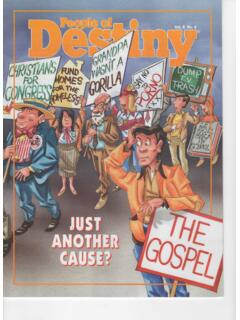Transcription of LEVITICUS - Classic Bible Study Guide
1 LEVITICUS A2 Classic Bible Study Guide 1 LEVITICUSL eviticus A2 Classic Bible Study Guide 2 INTRODUCTION As Genesis is the book of beginnings and Exodus the book of redemption, so LEVITICUS is the book of reconciliation and fellowship. It brings us into the tabernacle and opens to us all the privileges of access to the presence of God, and our place of blessing as His priestly household. Following are the seven main divisions into which the chapters of this book naturally fall. 1. The four offerings (chapters 1-7) 2. The priesthood (chapters 8-10) 3. The rites of cleansing (chapters 11-15) 4. The great Day of Atonement as the type (foreshadow) of reconciliation (chapters 16-17) 5. The statutes of holiness (chapters 18-22) 6.
2 Fellowship with God as typified in the great feasts (chapters 23-25) 7. Obedience and faithfulness (chapters 26-27) (The christ in the Bible , A. B. Simpson) LEVITICUS A2 Classic Bible Study Guide 3 LEVITICUS 1:1 7:38 Strictly speaking, we have five offerings described in these chapters, namely: the burnt offering (chapter 1); the grain offering (chapter 2); the fellowship offering (chapter 3); the sin offering (chapters 4, 5); and the guilt offering (chapter 5). Practically, however, the last two are identical in their main significance, both being of the nature of expiatory offerings to take away the guilt of sin, and its penal consequences. The sin offering was the fundamental one, prefiguring the great principles involved in christ 's propitiation for sin, the guilt offering seeming to refer rather to the provision made in christ 's death, for special acts of transgression and disobedience.
3 The order of LEVITICUS is at first sight very strange, commencing with the very highest aspect of christ 's sacrifice, and the one into which we are the last to enter, and closing with the simpler phases of His redeeming work, and those which we become first acquainted with in our experience in justification. The explanation is that God is moving outward in this progression, and therefore commences at the interior of the tabernacle, where He is at length to bring us, and ends outside the gate, where He finds us poor, helpless and guilty sinners, and then returns with us through all the stages of His gracious plan of salvation, as here unfolded. We shall, therefore, invert the order of these sacrifices in discussing them, not because we question the divine order and its extreme beauty, but because we desire to lead the reader through the stages of his own experience, and then return with him in the divine order backwards, to contemplate all the riches of grace in christ Jesus.
4 We shall commence with the sin offering ( LEVITICUS 4:1). It represents christ 's death for us, as God's propitiation for sin. We find three pictures of this sacrifice: 1. It was to be offered for the priest (4:1-12). This, however, was not necessary in the case of christ , who was sinless and needed no atonement for His own person (Hebrews 7:27). 2. It was offered for the whole congregation ( LEVITICUS 4:13-21). This represents the death of christ for all men. The several stages of this sacrificial act are full of spiritual significance. The sacrifice was to be offered by the elders of Israel (4:15), and by the laying of their hands upon the head of the victim. So christ was officially delivered to death by the council of the elders of Israel, as a sacrifice for the entire nation.
5 And Caiaphas, the high priest, was even inspired to announce to the people the necessity for this substitution. Then the bullock was slain, and its blood sprinkled seven times before the Lord, and before the veil (verses 16, 17). This denotes the death of christ and the offering of His life to God in place of our forfeited lives, and the perfection of this offering as meeting His claim upon our lives. Next, the fat of the bullock was separated and offered to God as a pure sacrifice, implying that there was something in christ which was directly presented to God, and had no connection with our sin; that is, that His death was an act of obedience to the Father, as well as a vicarious offering for the guilty (verse 19). Then came the most impressive part of the service.
6 The body of the bullock as an unclean thing was carried outside the camp, and burned to ashes as something unfit for sacrifice, and worthy only to be consumed. So christ was borne outside the camp, and crucified in ignominy as an accursed thing under the judgment of heaven, and the bane of earth, and literally "made him who had no sin to be sin for us" (2 Corinthians 5:21). Indeed, the word for offering in this passage literally means sin. So for us the sinless One became as it were, a mass of sin, and an accursed thing (Hebrews 13:12; 2 Corinthians 5:21). 3. For each individual, the sin offering must also be separately presented. It was not enough that it should have been offered by the whole congregation, but each one must separately present an offering for his own sin ( LEVITICUS 4:22-31).
7 So it is not sufficient that christ has died for the sins of the whole world, but each one of us must appropriate His sacrifice for our own sins. Two classes are here specified, namely, a leader, verse 22, and one of the common people, verse 27. But with great emphasis it is shown that both must come in the very same way. There is no royal road to mercy. "There is no difference, for all have sinned and fall short of the glory of God" (Romans 3:22-23). Then both must lay their hands on the head of the sin offering, and thus transfer their guilt to him (verses 24, 29). Both must receive atonement and forgiveness through the priest (verses 26, 31). In both cases the sprinkling of the blood seven times is omitted, for that was done once for all in the one sacrifice on Calvary; and all that the individual needs to do to be a partaker of the benefits of the sin offering is to recognize his sin, transfer it to the victim and appropriate his forgiveness and cleansing.
8 There are some most vivid and instructive features in this offering, on which for a moment we should dwell. It was the most realistic in its representation of the hideousness of sin of all the Hebrew offerings. Standing before the worshiper was an innocent snow-white lamb, bowing its gentle head at his touch. His soul is stained with guilt and sin, but the lamb had done no wrong. And now he lays his hand on that gentle head, and confesses over it all his guilt. Instantly the sin is transferred to the substitute, and it becomes, as it were, a mass of blackness, loathsomeness and hideous wickedness. Its little life is stricken out as by the blow of vengeance. Its body, laid open a LEVITICUS A2 Classic Bible Study Guide 4 hideous mass of uncleanness and laceration is dragged from the tabernacle as an offensive and unhallowed thing, and actually called by the very name of sin.
9 It is treated as something unfit to remain for a moment longer in the presence of God or His people, and hastily borne outside the camp to the fires where the filth of the camp is consumed, and there is hurled upon the flames and consumed to ashes as a spectacle of vengeance. Transfer all this to the person of Jesus, and behold Him in the place of this suffering lamb, and we have some idea of what is involved in His being "made .. sin for us" (2 Corinthians 5:21). Standing in our place, "the LORD has laid on him the iniquity of us all" (Isaiah 53:6), and immediately He became, as it were, a mass of inconceivable wickedness, and an accursed thing in the sight of earth and heaven. The judgments of God fell upon His head. The anathemas and insults of men were not too cruel for His deserving.
10 He was treated as though He had committed every abominable crime that man has ever committed, and as a thing unfit for either earth or heaven. He was nailed to the cross between the heavens and the earth, as a spectacle of shame and horror, until, consumed by the fires of death and judgment, with Him our sin was also consumed forever. This is the meaning of the act of appropriating faith. As we lay our hand upon His innocent head, our sin passes over to His person, and henceforth recognized as consumed and extinguished in the ashes of His dissolution. Our guilt, therefore, is declared to be put away and remembered no more, and our very sinfulness may be thus laid upon Him, that "the body of sin might be done away with" (Romans 6:6).







